Embark USS Carl
Vinson, June 11-12, 2004
This was a life time experience and the excitement was beyond
expression.
Sixteen of us, from education commuity, business sector, television
production,
research team, and ESGR, gathered in NAS North Island, the Brith Place
of
Naval Aviation, San Diego, CA, were ready for the embarkment on
USS
Carl Vinson. USS Carl Vinson is one of the six aircarft
carriers
that consist of the United States Naval Air Force Pacific Fleet.
USS
Carl Vinson is named after former Congressman Carl Vinson, who served
as
the chairman of the Naval Affairs Committee having great influence on
the
development and construction of the pre- and post- World War II United
States Navy. Carl Vinson was the first US citizen to see the
launching of
a ship named in his honor.
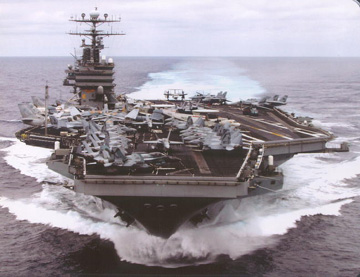
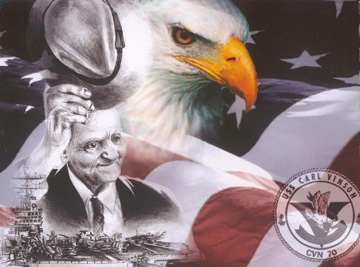
Commissioned in March 1982 and the third Nimitz nuclear powered
aricraft
carrier, USS Carl Vinson is 1,092 feet long and displaces 91,000
tons.
With a crew of over 5,000, including her embarked air wings, the
aircraft
carrier is capable of launching any of its 70+ aircrafts from four
steam
catapults. Naval Station Bremerton in the state of Washington was
the
homeport for the USS Carl Vinson since Jan. 1997. In Jan.
2005,
the "Gold Eagle" USS Carl Vinson bid farewel to her home port
Bremerton,
Washington, and the Pacific Northwest to participate in a Joint
Task
Force Exercise (JTFEX), followed by her around-the-world deployment.
While
at sea, the ship will honor our nation’s cooperative security
commitments
to our friends and allies overseas, promote peace and stability.
Upon
completion of her deployment, the "Gold Eagle" will arrive in Norfolk,
VA,
to begin a refueling and complex overhaul (RCOH), the three-year
maintenance
period which will virtually turn the ship into a new carrier with some
of
the most modern equipment in the Navy and allow it to serve at least
another
25 years.
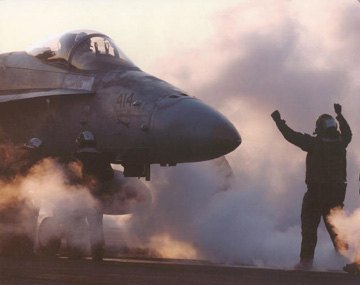
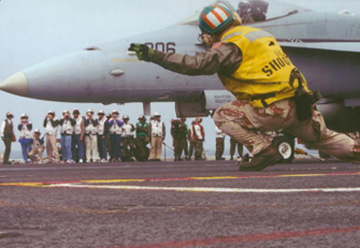
The Carl Vinson Carrier Strike Group includes Carrier Air Wing 9,
Destroyer
Squadron 31, the guided-missile cruiser USS Antietam (CG 54), the
guided-missile
destroyers USS O’Kane (DDG 77) and USS Mustin (DDG 89), the fast combat
support
ship USS Camden (AOE 2) and the submarine USS Olympia (SSN 717).
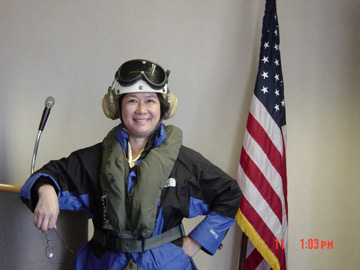
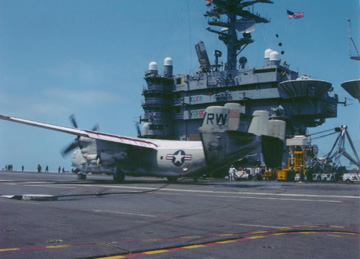
We are getting ready to get on the C-2A Greyhound to fly to USS
Carl Vinson. Referred to as the COD, the C-2 is capable of
carrying
five tons of cargo, 26 passengers, and thousands of pounds of
mail.
C-2 serves as a vital link between shore stations and at-sea aircraft
carrier
battle groups. We were seated facing backward in the cabin.
Restraining
harnesses held us firmly in our seats during the arrested landing and
catapult launching. When the landing aboard the carrier, the C-2
aircraft came
down from flying speed of 130 mph to zero in a space of about 200
feet.
At launching, the plane went from zero to 130 mph in less than two
seconds.
Anyone who has experienced such a thrill of lifetime would be awarded a
certificate
of Honorary Tailhooker by the captain of the carrier. Our
flight
was about 30 minutes from North Island, CA, to the landing on USS Carl
Vinson.
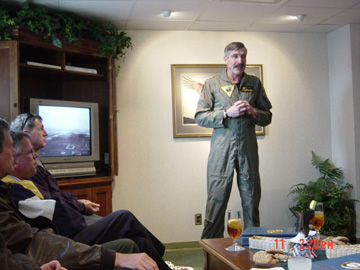
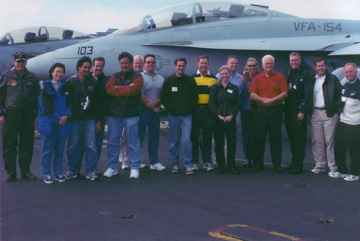
Upon landing on USS Carl Vinson, we are greeted by Rear Admiral Evan M.
Chanik, Commander of Carrier Group Three which includes a carrier and
her air wings, a destroyer, a few cruisers, submarines, and logistic
ships. The Admiral has an office on board the carrier and he has a busy
flying
schedule that day. Constantly, we are forgetting that we were not
on the gound as the carrier is indeed like a city on the high
sea.
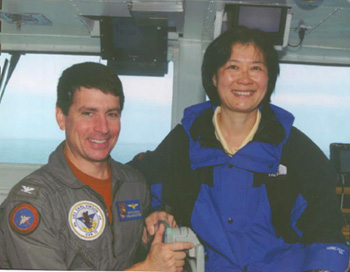
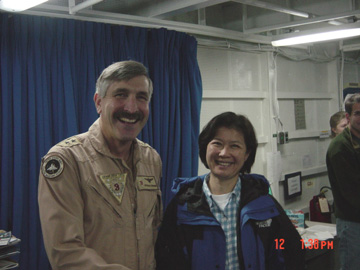
With Captain Kevin M. Donegan,
With Rear Adminral Evan M.
Chanik, Commander,
Commanding Officer, USS Carl
Vinson.
Carrier Group Three.
We were given a chance to
sit
on his
chair in his command room.
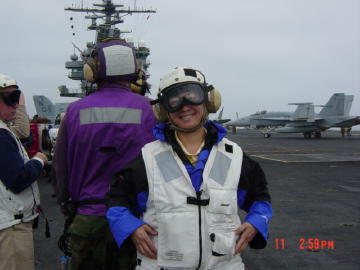
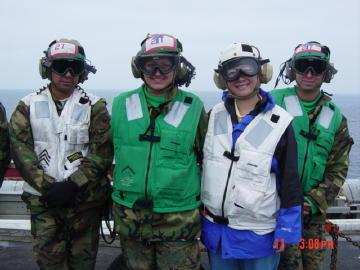
Before boarding the carrier, we are informed
that crew members
working on the deck wear jacket of different color, each
indicates their duty and responsibility. Brown: plane captains,
Green: maintenance, Red: Ordnance
(loading or unloading bombs), Yellow:
Directors, Purple: fuels, Blue: handlers, and White:
safety/medical/visitors. All the visitors are wearing white
jackets. I am with a few crews: two are maintenance and one is in
safety. You can tell the crew to my right hand side is a
female. About 12% of the crew on board the carrier is
a woman.
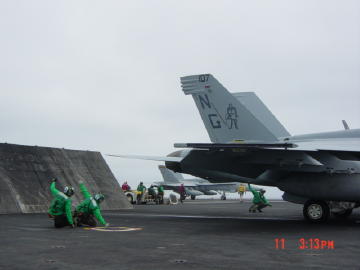
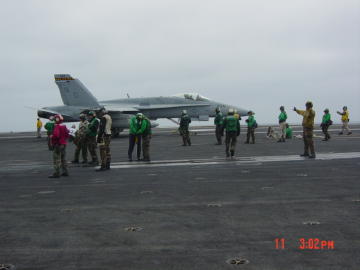
Left: The fighter is ready to take off. Crews in different
collored jacket are in the background. No one can perform such a
choreography
in precision better than they can. Right: Crews between the
landing
and taking off.
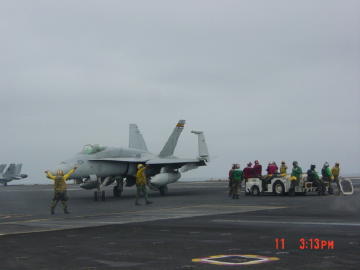
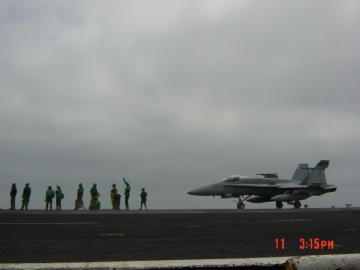
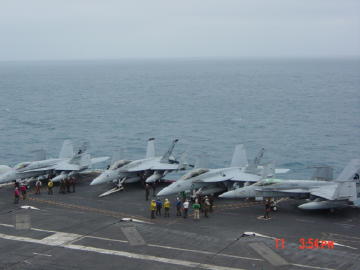
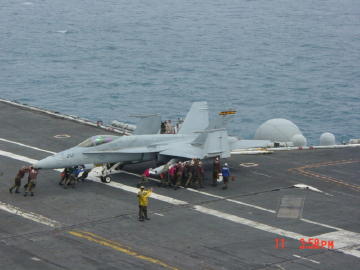
More pictures showing crews in different jackets at
work.
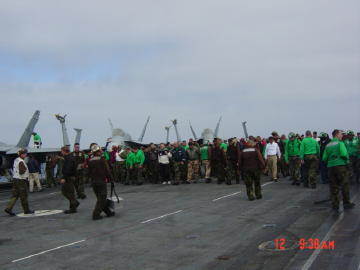
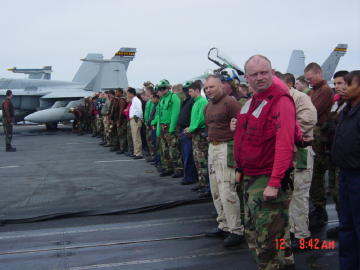
Often, all the crew members including those who work underneath in
different war rooms will come up to the deck to "walk" trying to find
any suspicous pieces on the floor that might jepardize fighter planes'
normal flight.
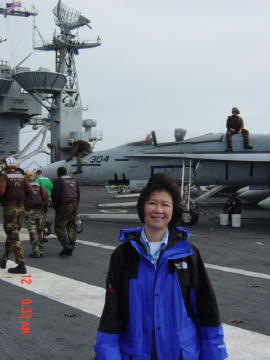
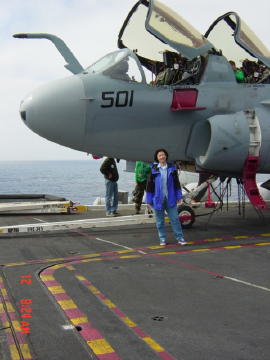
With some of the crews on the deck.
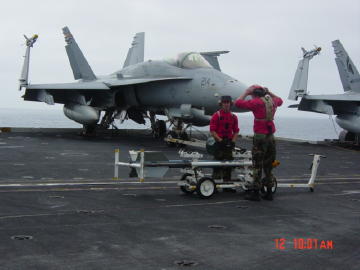
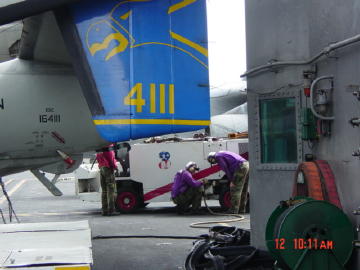
The Bomb crew at work (red jacket).
The fuel
crew at work (purple jacket).
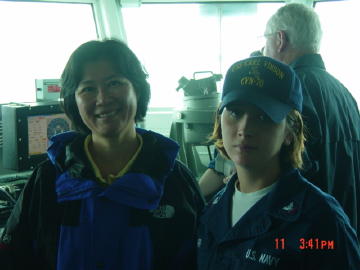
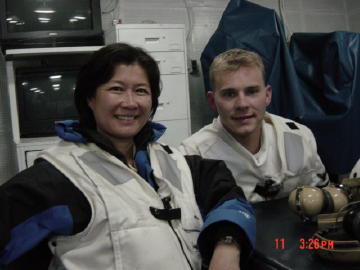
With one of the female crew
members.
JO3 Chris Fahey is one of the staff in the
Carrier's
Public Affairs Office.
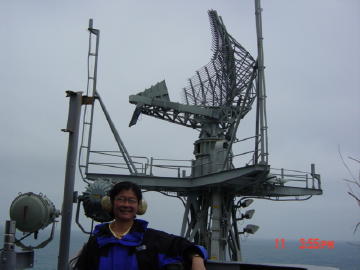
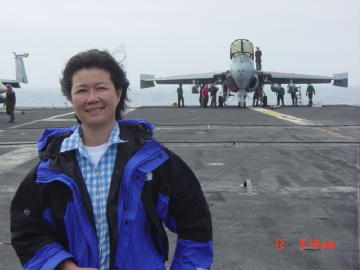
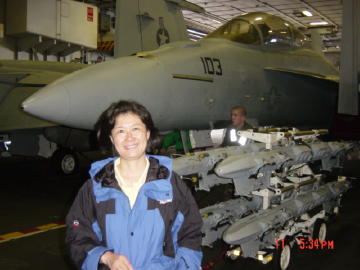
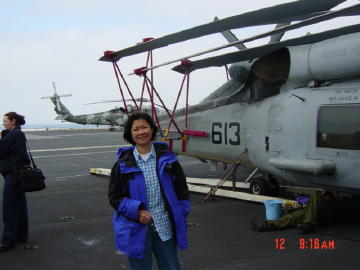
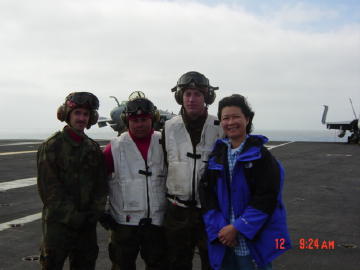
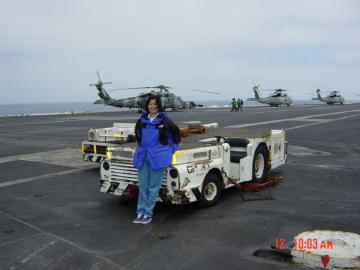
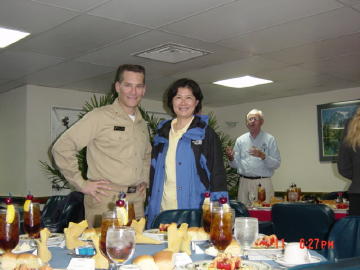
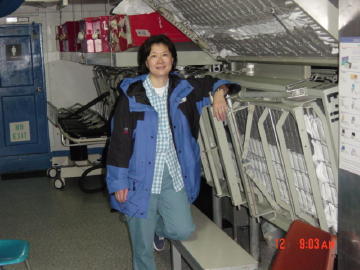
With Lt. Commander Daniel Hohman who is also a flight surgent.
He runs the carrier hospital with
half dozens of doctors,
35 personnel, 50 beds, and other medical professionals. His
clinic is capable
of operating necessary surgery,
providing routine checkup, and responding emergency calls
for the
crews.
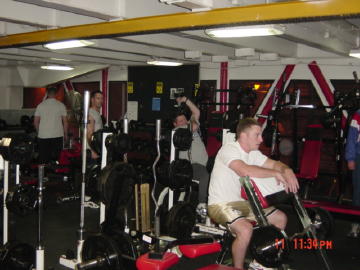
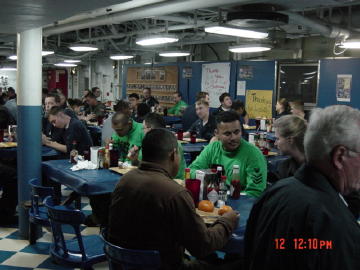
Fitting room. It is the only place on board
Dinning
Room. The food actually is quite good,
that
the sailors do not have to wear uniform.
but there is always a long
line.
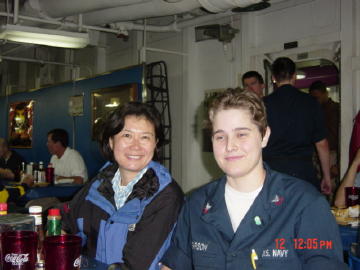
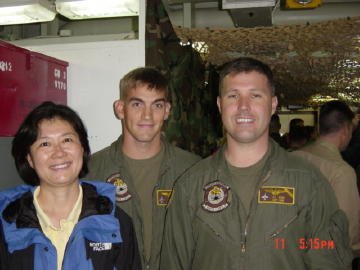
Second class Pason, who works in the reactor
room.
With two Marine pilots on
board.
Currently all the US carriers are nuclear powered.
Working in the nuclear powered reactors can be
dangerous. But
Parson said she is not so worried.
"If something should happen and I have to die,
God will take care of the
rest. We were all given
opportunity in traing school if we
chose not to work
with nuclear power equippment."
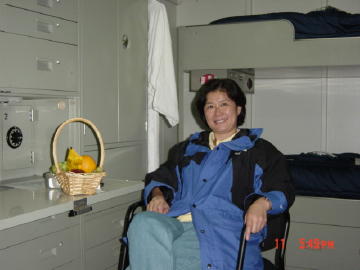
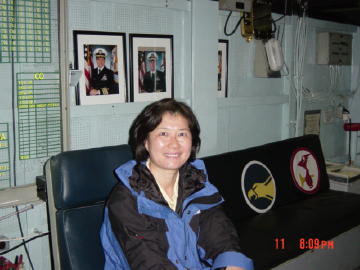
In my room on board. It is quite
spacious
In the conference room.
and comfortable.
It is a guest room after all.
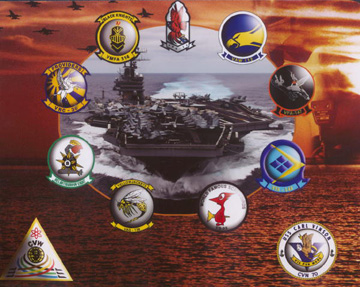
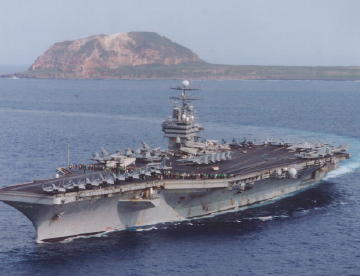
The average age of the crews on board is 20 years old. Many
of them are fresh from high school.
They are operating million-dollor
worth of machinery, flying the best equipped fighters, defending not
only
our nation but also a world so far away yet so close to home.
Each
of them has the smallest space
as "home" but lives with probably the largest
family of several thousand members. The carrier is a city
that never sleeps and an island that floats. The commanding
officers of Carl Vinson
call these sailors
"young adults" with great compliment and pride.
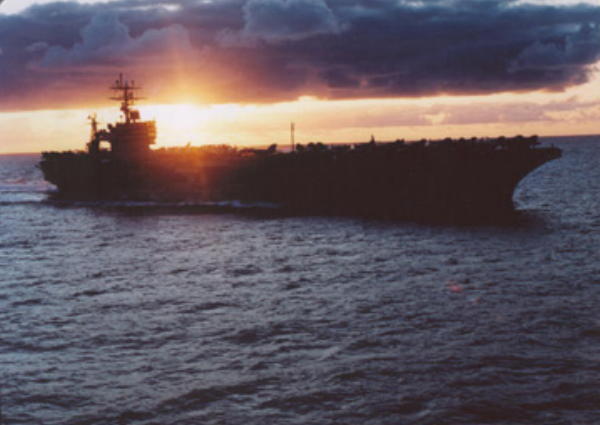
As we were flying away from USS Carl
Vinson, the carrier stood elegantly against the bueatiful Californian
sunset. I said
good bye to this giant city and a great family. Driving away from
the North
Island where we initially boarded the flight, it was time for me
to retire in a hotel, but for many of the young adults aboard USS Carl
Vinson, their day had just begun.













